
Inspiration from the Fuel Lines ad agency new business conference in Nashville
They say that plumbers don’t always fix their own leaky pipes and the same is often true for marketing companies.
A few years ago I hired Michael Gass of Fuel Lines to help us further refine our positioning as a digital marketing agency and to help us stop the leaks in our own marketing.
He flew up from Alabama and brought his Southern charm and buckets full of wisdom with him.
After a long successful career in business development, Michael started his own business specializing in helping advertising agencies get more leads and sales. He has worked with over 200 agencies worldwide and I just spoke at his insightful ad agency conference in Nashville.
If you have ever wondered if specializing in a niche or focusing on highly specific target markets could help your services business succeed, then you’re in for a real treat via the takeaways from this positioning and inbound marketing conference.
How to create a line out the door for your business
- Positioning and picking a niche and/or target market
If I had a dollar for every time I heard the words “Focus on a highly specific target market and you will have clients flocking to you and paying higher prices”, I could buy a 30 foot sport fishing boat.
Some people at the conference debated whether or not you should focus just on one target market versus having several segments but this was one of the main themes throughout the conference.
Advertising agencies certainly can have more than one target market but having more than three and/or not having specialized people to handle each of them can cause a problem for small to mid-size companies.
Mark Schneider of RSW/US at the recent HubSpot inbound marketing conference said that clients don’t expect you to work only in their industry but they do like to see about 30% or more of your team focusing on one vertical.
Lee McKnight Jr. of RSW/US at the Fuel Lines conference said that even if you don’t focus on a client’s target market, they say it’s critical you at least “own” something you are well known for.
Numerous speakers joked about how advertising agencies claim they are different by saying they are more creative, strategic and/or are better partners than their competition.
This was looked down upon as a weak value proposition across the board and is not enough to make you stand out in a very competitive field.
Owning your target market and/or niche has also been proven to consistently lead businesses and their “visible experts” to be called upon by the media for their specific expertise.
Everything gets easier when you narrow your focus.
- Blogging and developing consistent content for building authority
The other major high-level theme of the conference was that agencies should develop blogs either on their own website or on a separate very specific domain name, relating to just one industry or niche topic.
Michael’s philosophy is that its best if this blog is largely centered around one individual person as opposed to a brand or group effort.
Having a content driven website and blog focused on industry related keywords will help you quickly become the go to person in that category.
By putting the blog on a separate URL, you can experiment with this type of targeting without having to completely rebrand your main website.
One example is the Millennial Marketing blog by Jeff Fromm
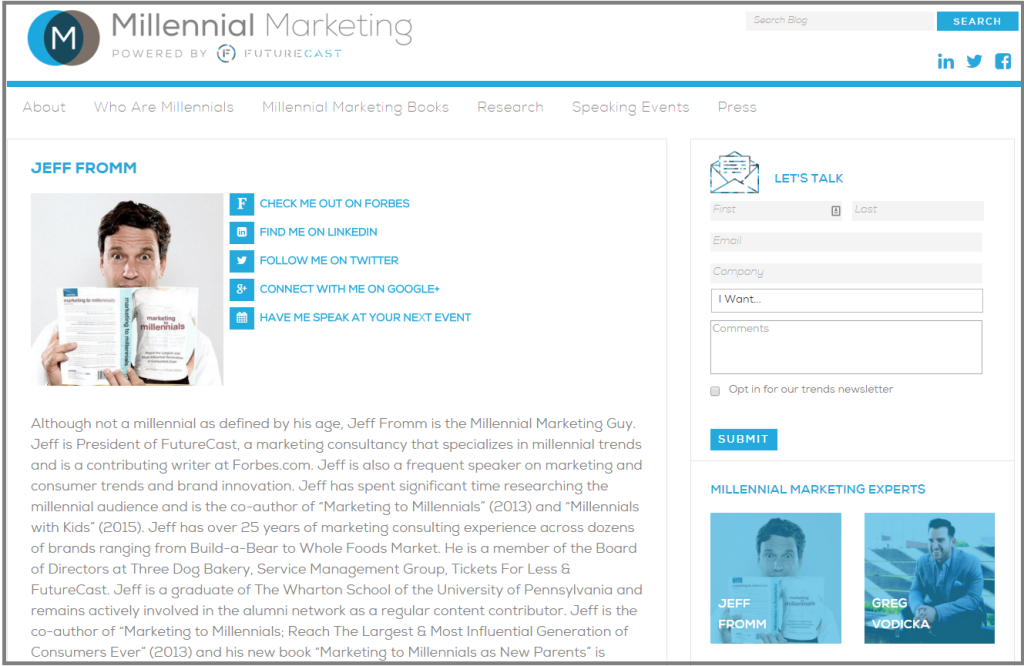
Another niche blog example is the Sheconony, written by Stephani Holland
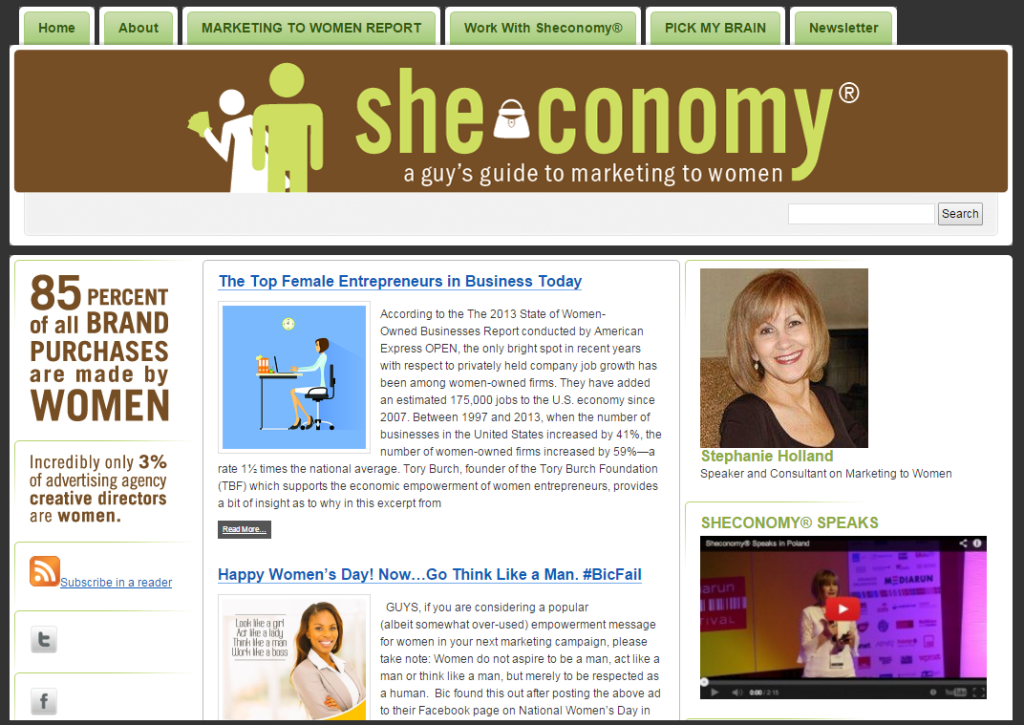
Jami Oetting from HubSpot, who writes The Agency Post, countered this in some ways because she likes to have all of the content on one website. Given HubSpot starts at $800 a month for the pro version, I only have it on my main agency site, so I have also felt the practical implications of this from a tracking and tool cost perspective.
Jami recently moved agencypost.com into the main HubSpot website and now has a better feel for tracking and leads coming from this content but it’s worth exploring both scenarios as you map out your strategy.
Just be careful not to have too many websites and blogs because I can tell you from experience it can be a real challenge to manage the process on numerous sites at once.
With that said, exploring, experimenting and even failing, is going to help you succeed in the long run. Doing nothing is definitely worse.
How often should I blog?
From a tactical perspective, Jami mentioned some recent HubSpot stats that show when companies blog 16+ times a month they get a significant increase in traffic.

In a 2015 post titled How Often Should Companies Blog?, Lindsay Kolowich of HubSpot explains the research in more detail:
“Companies that published 16+ blog posts per month got about 4.5X more leads than companies that published between 0 – 4 monthly posts.”
How long will it take for my blog to succeed?
Certainly starting with one blog post a month is better than nothing and it all depends on how quickly you want to see success.
One blog post a month will be enough to share this niche content with your target audience and can deeply improve your sales process but won’t be enough for a serious SEO effort.
400 blog posts was cited as a threshold where blogs reach a significant inflection point and several people discussed how it took one or two years for their blogs to take off.
In my presentation, I shared this analytics graphic from the wife of famous “SEO expert” Rand Fishkin, who only saw her blog have deep ranking success after two years of hard work.
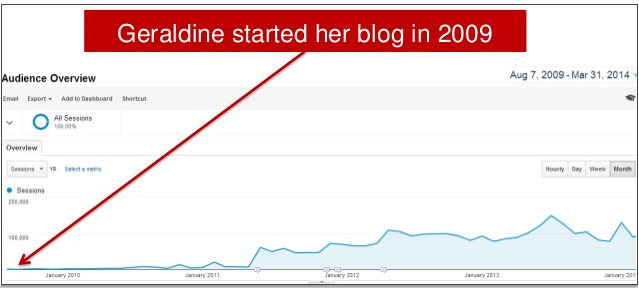
Should I write shorter blog posts or longer more in depth posts?
Michael Gass likes short posts and has gotten over a million views on 500 words posts but Jami from HubSpot says they do far better with 2,500 word posts. Searchmetrics, in their 2015 ranking factors study, recently revealed that the length of content that ranks well continues to increase – to over 1,100 words on average.
Check out more from Ginny Soskey / HubSpot on Quality vs. Quantity: A 6-Month Analysis of the Age-Old Blogging Debate.
In the end it will depend on your audience and goals but the trend for SEO and sharing is longer posts. Ideally include lots of detailed research, bullet points, images and or video while at the same time making it easy to read.
With over 150 million blogs out there, blogging for the sake of just having one is completely dead.
- Email marketing still dominates
Lee McKnight of RSW says that 57% of marketers find agencies via email.
Prospecting to potential new customers via email can be more productive than you would think given people’s saturated inboxes.
Capturing emails by using top of the funnel calls to action such as e-books was one of the top ways mentioned to build a quality list.
Another person mentioned using Datanyze to capture emails of people you find on LinkedIn.
Michael Gass prefers that the agencies he worked with use as simple a strategy as possible when starting an email Campaign.
Rather than crafting new content for your email marketing every month, he recommends simply putting the four most recent blog posts as snippets into an email with links to the full posts. This way you can get your monthly emails out consistently.
Check out the post on Copyblogger that compares the effectiveness of a fully crafted monthly email newsletter to what they call content notifications.
- Cold calling is dead but warm calling is not
While having an amazing blog that generates an overabundance of leads is the ideal, you may need to do some calling while you are building up to being a 100% inbound lead driven agency.
Lee McKnight from RSW/US said that a call is never the first step in the process.
The first step is preferably to send some thought leadership content such as an e-book or link to a blog post that you have created to the client. You can email them or mail them survey results, an info-graphic or whatever you think will inspire them to want to talk to you when you follow up with a phone call.
Nobody likes to get cold calls and it’s not exactly the favorite tactic of marketers at this conference but in reality most people still use this tactic, including HubSpot and Google!
If you are going to put cold calling into your mix while ramping up your blog, make sure to connect it to helpful industry specific content, so you’re not just annoying people.
- Social media marketing for amplifying your message
Social media doesn’t usually convert into leads like other tactics but it can be a great way to spread your content, position yourself as a thought leader and engage customers.
Michael Gass has over 100,000 Twitter followers across 2 Twitter accounts (personal and business) and says that it drives a ton of traffic to his website.
Paul Roetzer from PR 20/20 showed a survey slide, where the number one thing marketers were focused on was social. He mused at it and said that, as you can see, clients basically don’t know what works and or exactly what they want.
Social media marketing should not be the very first thing that most customers of an agency focus on unless they are in a very specific industry where social is dominant.
With that said, given the fact that so many marketing directors fixate on social media, it doesn’t position you well if your own social media stinks.
And while search engine optimization does not directly improve because of social media, most top ranking websites according to Searchmetrics also have considerable social activity.
Promoting your blog and content is next to impossible without the use of social media, so this category stands in reasonably high regard with the agency crowd.
Numerous people also mentioned how journalists take your Twitter and social activity very seriously.
Everybody agrees that Facebook is the big dog in general and that it’s great to put somewhat touchy-feely stuff on there to show the charitable and soft side of your agency but if you want leads as a services firm, then go to LinkedIn.
LinkedIn promoted content and using an advanced tool like LinkedIn Navigator can be great ways to enhance your LinkedIn strategy.
Both Michael Gass and Jami from HubSpot went into some detail about publishing on LinkedIn Pulse as a way to greatly expand the reach of your blog. They both appeared to take the approach of not worrying about duplicating content as long as you link back to your blog post after copying and pasting it into LinkedIn Pulse.
I have heard some other SEO expert’s saying that the preferred method is to put a few hundred word synopsis of your blog post into LinkedIn Pulse, so the content is original. There is certainly some debate about this and I would love to hear other people’s experiences.
- Clear calls to action
A common theme that Michael Gass sees with many of his ad agency clients is a lack of clear and simple calls to action.
At McDougall Interactive we have been guilty of having too many calls to action at times and other agencies don’t even have a top of the funnel call to action yet.
I know the feeling, as I am still working on our first e-book for Authority Marketing.
Michael and other speakers discussed the idea of adjusting calls to action on a regular basis to improve conversions.
Having relevant e-books at the end of a blog post can help significantly for lead generation.
- Sales psychology
One of my favorite takeaways was the idea of playing a bit of a chess game in the sales process.
Peter Levitan, author of Buy This Book. Win More Advertising Pitches, made a very strong point around how agencies focus so much on solving the clients problem that they don’t bond around the problem itself. By doing this you might take down a pawn but lose the king.
Companies are much more focused on their own issue than they are on listening to you spout off ideas. It builds a better relationship to huddle around the problem first and empathize.
Bob Sanders of Sanders Consulting Group gave an amazing presentation which included his phenomenal system for creating chemistry through personality profiling.
Bob breaks human people types into four categories and helps you identify which type of people your prospects are. This helps you to mirror their activities and style, as well as create a better bond with them.
Which personality type are you?

Numerous people discussed the idea of building personas and understanding your customers in detail before going into a pitch. Private detective type of work to understand a prospect may sound creepy but it helps you bond with a prospect more quickly. LinkedIn is a great place to start this type of research.
Another consensus was around the idea of “stirring the hurt” or bringing the problem the customer is having to the forefront, in a way that creates a serious sense of urgency.
Customers can be so slow to get on board with getting things done that you need to make them painfully aware that their problem could get worse if they don’t work on the solution immediately.
- Improving your systems and processes along with deepening consistency
One thing that struck me very deeply after going to several conferences in the last month is just how smart so many marketers are and how organized they are about their systems.
Lee from RSW/US has an amazing template on their new business outreach system as well as sales email templates.
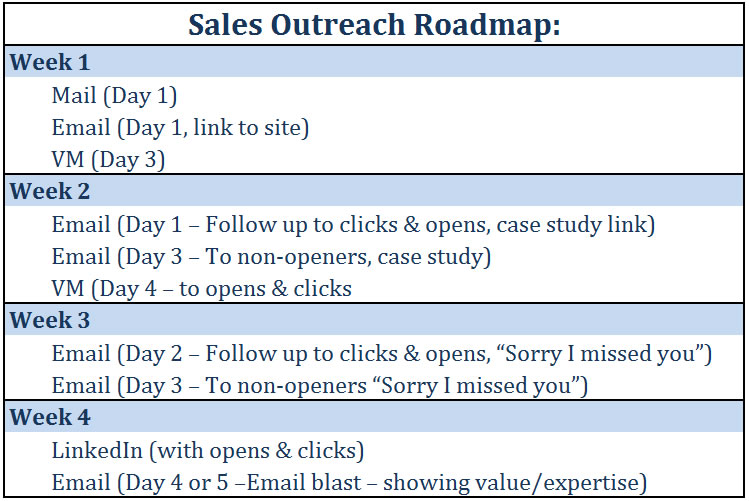 Paul from PR 2020 has incredible spreadsheets such as the following goal tracking worksheet.
Paul from PR 2020 has incredible spreadsheets such as the following goal tracking worksheet.
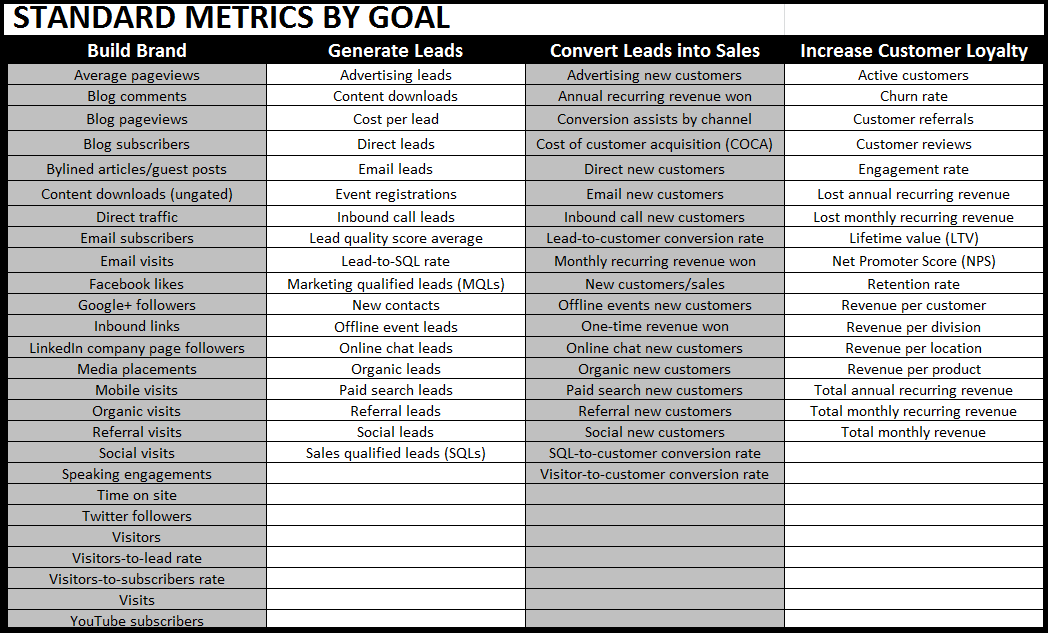
Jeff Fromm the millennial marketing guy said to create a spreadsheet with 100% of all your prospects and give each of them a percentage score in terms of the likelihood of them signing up and a monetary value. And then he said to basically throw out anything with under a 50% score.
Michael Gass spoke in depth about creating a system of creating content and outlined the process for creating a blog posts, the different styles of posts you should create each month and systematic ways of promoting them.
HubSpot is famous for helping agencies to define the sales process and has numerous onboarding workflow charts and spreadsheets.
Another speaker mentioned having a one page brand strategy document or manifesto to keep all of your messaging consistent.
Michael Gass joked about how few agencies have a marketing plan for the own companies.
If you ever want to sell your company someday, having workflows and highly developed systems in place, not only makes your company function better but makes it more of a target to be purchased. In the meantime it helps you and your team to be happier and more successful.
Pier Levitan talked about creating a highly organized methodology for responding to RFPs and how you put your pitches together.
If you’re the kind of company that doesn’t spend the time to organize your systems, then it’s time to take a page out of these marketing experts playbook.
- Digital marketing tools and martech
Paul from PR 2020 mentioned the famous info-graphic by Scott Brickler on marketing technology tools and just how much software marketers need to work with these days.
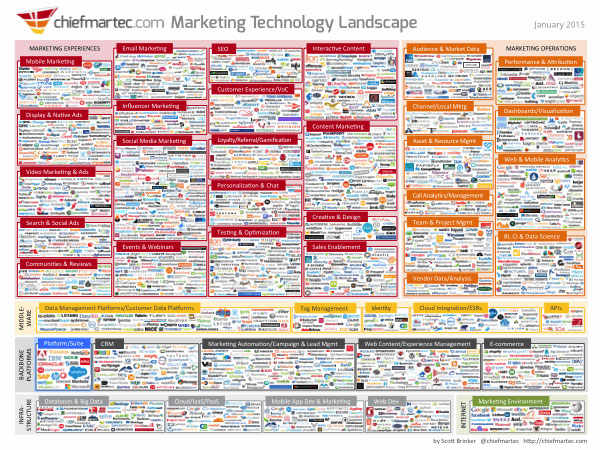
He discussed how chief marketing officers are now spending more money on technology than chief information officers!
Marketing is getting more complicated and if you are not aware of the tools that can help you save time, you’re behind the curve. Here are just a few of the tools that were mentioned:
HubSpot
SocialOomph
HootSuite
Datanyze
Automated Insights
The List
Conclusion
Whether you’re an advertising agency or any type of services company, specialization in terms of the tactics you employ and/or the target markets that you focus on are essential in today’s competitive climate.
Michael Gass in his closing keynote said that “there’s one thing that is consistent with experts and that is experts write.”
By specializing in having a blog that you can turn into e-books and an eventual book, you will be positioning yourself in a way that will allow you to have a red velvet rope policy and to only work with clients that you enjoy working with.
Are you working with only your ideal clients?
